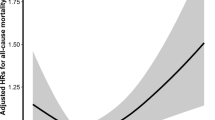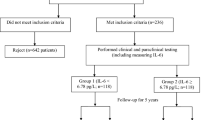Abstract
Purpose
We investigated the role of serum uric acid (sUA) and superoxide dismutase (SOD) as predictive factors for mortality in hemodialysis (HD) patients.
Methods
SOD, butyrylcholinesterase, and malondialdehyde were estimated spectrophotometrically and the other parameters by standard procedures. High-sensitive C-reactive protein was assayed by a sandwich ELISA method.
Results
sUA among survivors (112.1 ± 13.82 μmol/L) was significantly lower than in deceased (160.8 ± 16.81 μmol/L, p < 0.001), while SOD was higher in survivors (31.8 ± 6.61 kU/L) than among deceased (20.2 ± 3.03, p < 0.05). Kaplan–Meier survival curves showed the greatest mortality risk in the highest tertile of basal sUA concentration (≥127.11 μmol/L, p < 0.001), and for SOD in the lowest tertile (≤23.83 kU/L, p < 0.05).
Conclusion
Our results suggest that high sUA and low SOD may predict all-cause and cardiovascular mortality in HD patients.




Similar content being viewed by others
References
Sombolos K, Tsitamidou Z, Kyriazis G, Karagianni A, Kanteropoulou M, Progia E (1997) Clinical evaluation of four different high-flux hemodialysers under conventional conditions in vivo. Am J Nephrol 17:406–412
Feig DI, Johnson RJ (2003) Hyperuricemia in childhood primary hypertension. Hypertension 42:247–252
Feig DI, Soletsy B, Johnson RJ (2008) Effect of allopurinol on blood pressure of adolescents with newly diagnosed essential hypertension: a randomized trial. JAMA 300:924–932
Feig DI, Kang DH, Johnson RJ (2008) Uric acid and cardiovascular risk. N Engl J Med 359:1811–1821
Lin JD, Chiou WK, Chang HY, Liu FH, Weng HF (2007) Serum uric acid and leptin levels in metabolic syndrome: a quandary over the role of uric acid. Metabolism 56:751–756
Dawson J, Walters M (2006) Uric acid and xanthine oxidase: future therapeutic targets in prevention of cardiovascular disease? Br J Clin Pharmacol 62:633–644
Hozawa A, Folsom AR, Ibrahim H, Javier Nieto F, Rosamond WD, Shahar E (2006) Serum uric acid and risk of ischemic stroke: the ARIC Study. Atherosclerosis 187:401–407
Fang J, Alderman MH (2000) Serum uric acid and cardiovascular mortality: the NHANES I epidemiologic follow-up study, 1071–1992. National Health and Nutrition Examination Surve. JAMA 283:2404–2410
Annuk M, Zilmer M, Fellistro B (2003) Endothelium-dependent vasodilatation and oxidative stress in chronic renal failure: impact on cardiovascular disease. Kidney Int 63:S50–S53
Sies H (1997) Oxidative stress: oxidants and antioxidants. Exp Physiol 82:291–295
Locatelli F, Canaud B, Eckardt KU, Stenvinkel P, Wanner C, Yoccali C (2003) Oxidative stress in end-stage renal disease: an emerging threat to patient outcome. Nephrol Dial Transplant 18:1272–1280
Ramos R, Martinez-Castelao A (2008) Lipoperoxidation and hemodialysis. Metab Clin Exp 57:1369–1374
Suresh DR, Delphine S, Agarwai R (2008) Biochemical markers of oxidative stress in predialytic chronic renal failure patients. Hong Kong J Nephrol 10:69–73
Chamorro A, Obach V, Cervera A, Revilla M, Deulofeu R, Aponte JH (2002) Prognostic significance of uric acid serum concentration in patients with acute ischemic stroke. Stroke 33:1048–1052
Amaro S, Soy D, Obach V, Cervera A, Planas AM, Chamorro A (2007) A pilot study of dual treatment with recombinant tissue plasminogen activator and uric acid acute ischemic stroke. Stroke 38:2173–2175
Felström BC, Jardine AG, Schmieder RE et al (2009) Rosuvastatin and cardiovascular events in patients undergoing hemodialysis. N Engl J Med 360:1395–1407
Chan KE, Ikzler A, Gamboa GL et al (2011) Combined angiotensin-converting enzyme inhibition and receptor blockade associate with increased risk of cardiovascular death in hemodialysis patients. Kidney Int 80:978–985
Alcantara VM, Chautard-Freire-Maia EA, Scartezini M, Cerci MS, Braun-Prado K, Picheth G (2002) Butyrylcholinesterase activity and risk factors for coronary artery disease. Scand J Clin Lab Invest 62:399–404
Stojanov M, Stefanovic A, Dzingalasevic G, Mandic-Radic S, Prostran M (2011) Butyrylcholinesterase activity in young men and women: association with cardiovascular risk factors. Clin Biochem 44:623–626
Garsia SC, Wyse ATS, Valentini J et al (2008) Butyrylcholinesterase activity is reduced in hemodialysis patients: is there association with hyperhomocysteinemia and/or oxidative stress? Clin Biochem 41:474–479
Stojanov MD, Jovicic DM, Djuric SP, Konjevic MM, Todorovic ZM, Prostram MS (2009) Butyrylcholinesterase activity and mortality risk in hemodialysis patients: comparison to hsCRP and albumin. Clin Biochem 42:22–26
Mekki K, Taleb W, Bouzidi N, Kaddous A, Bouchenak M (2010) Effect of hemodialysis and peritoneal dialysis on redox status in chronic renal failure patients: a comparative study. Lipids Health Dis 9:93–99
Zvolińska D, Grzeszczak W, Kiliś-Pstrusińska K, Szprynger K, Szczepańska M (2004) Lipid peroxidation and antioxidant enzymes in children with chronic renal failure. Pediatr Nephrol 19:888–892
Hambali Z, Ahmad Z, Arab S, Khazaai H (2011) Oxidative stress and its association with cardiovascular disease in chronic renal failure patients. Indian J Nephrol 21:21–25
Cross J (2002) Endothelial dysfunction in uremia. Blood Purif 20:459–461
Matsuoka H (2001) Endothelial dysfunction associated with oxidative stress in human. Diabetes Res Clin Pract 54:S65–S72
Heltzer T, Schlizing T, Krohn K, Meinertz T, Munzel T (2001) Endothelial dysfunction, oxidative stress, and risk of cardiovascular events in patients with coronary artery disease. Circulation 104:2673–2678
Madero M (2008) High levels of uric acid linked to CKD death risk. Renal Urol News July 11
Hsu SP, Pai MF, Peng YS, Chiang CK, Ho TI, Hung KY (2004) Serum uric acid show a “J-shaped” association with all-cause mortality in hemodialysis patients. Nephrol Dial Transplant 19:457–462
Backer BF (1993) Towards the physiological function of uric acid. Free Radic Biol Med 14:615–631
Ginsberg MH, Kozin F, O’Malley M, Mc Carty DJ (1977) Release of platelet constituents by monosodium urate crystals. J Clin Invest 60:999–1007
De Scheerder JK, van de Kraay AM, Lamers JM, Koster JF, de Jong JW, Serruys PW (1991) Myocardial malondialdehyde and uric acid release after short-lasting coronary occlusions during coronary angioplasty: potential mechanisms for free radical generation. Am J Cardiol 68:392–395
Ramos R, Martinez-Castelao A (2008) Lipoperoxidation and hemodialysis. Metab Clin Exp 57:1369–1374
Bagnati M, Perugini C, Cau C, Borbone R, Albano E, Bellomo G (1999) When and why a water-soluble antioxidant becomes pro-oxidant during copper-induced low-density lipoprotein oxidation; a study using uric acid. Biochem J 15:143–152
Perugini C, Seccia M, Albano E, Bellomo G (1997) The dynamic reduction of Cu(II) to Cu(I) and not Cu(I) availability is sufficient trigger for low density lipoprotein oxidation. Biochim Biophys Acta 1347:191–198
Tonelli M, Wiebe N, Hemmelgarn B et al (2009) Trace elements in hemodialysis patients: a systematic review and meta-analysis. BMC Med 7:25–37
Santos CXC, Anjos EI, Augusto O (1999) Uric acid oxidation by peroxinitrite:multiple reactions, free radical formation, and amplification of lipid oxidation. Arch Biochem Biophys 372:285–294
Abuja PM (1999) Ascorbate prevents prooxidant effects of urate in oxidation of human low density lipoprotein. FEBS Lett 446:305–308
Acknowledgments
This work was supported by grants from the Ministry of Education and Science, Republic of Serbia (Projects No. 175023 and 175035).
Conflict of interest
None.
Author information
Authors and Affiliations
Corresponding author
Rights and permissions
About this article
Cite this article
Antunovic, T., Stefanovic, A., Ratkovic, M. et al. High uric acid and low superoxide dismutase as possible predictors of all-cause and cardiovascular mortality in hemodialysis patients. Int Urol Nephrol 45, 1111–1119 (2013). https://doi.org/10.1007/s11255-012-0233-x
Received:
Accepted:
Published:
Issue Date:
DOI: https://doi.org/10.1007/s11255-012-0233-x




